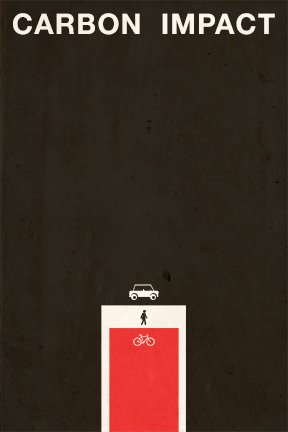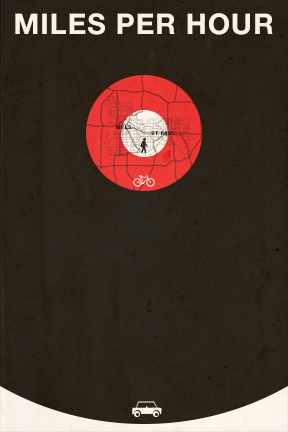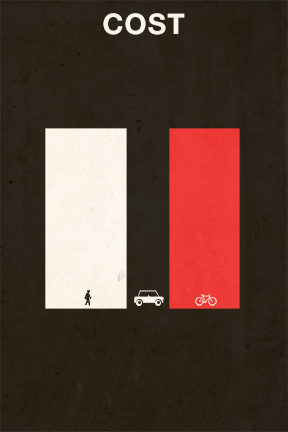


|
||

|
||
PROPAGANDA |
||
|
|
||


|
|

|
2.1 pounds of CO2 per mile |
|
|
||
|
|

|
0.18 pounds of CO2 per mile |
|
|
||
|
|

|
0.12 pounds of CO2 per mile |
|
|
||
|
|
||
|
|
||

|
|

|
60 mile radius |
|
|
||
|
|

|
4 mile radius |
|
|
||
|
|

|
10 mile radius |
|
|
||
|
|
||
|
|
||

|
|

|
$727 per month |
|
|
||
|
|

|
$85 per month |
|
|
||
|
|

|
$73 per month |
|
|
||
|
|
||
|
|
||

November 27, 2019 CARBON IMPACT - Driving a gasoline powered car produces about 1 pound of carbon dioxide (CO2) per mile. (source) - Manufacturing a car also produces CO2. Over the lifetime of the average car, the manufacturing "cost" is about 1.1 pounds of CO2 per mile. (source) - Added together, this means that driving a car emits about 2.1 pounds of CO2 per mile. - This also means that driving electric cars won’t save us. Without any fossil fuel consumption, a car still "emits" 1.1 pounds of CO2 per mile because of the pollution created through manufacturing. - Riding a bicycle also uses fuel. Riding a bike burns calories. The more you exercise, the more you have to eat and food production has a CO2 impact. - The average rider produces 0.06 pounds of CO2 emissions per mile by way of consuming more food. This number goes up if that extra food is meat. It goes down if that extra food is kale. (source) - The CO2 "costs" of manufacturing a new bicycle are also about 0.06 pounds per mile. (source) - So riding a bike produces about 0.12 pounds of CO2 per mile, about 5% of a car's 2.1 pounds. - Walking burns almost 3 times as many calories per mile as bike riding. (source) - With no manufacturing "costs" walking produces about 0.18 pounds of CO2 per mile. It takes more calories to walk a mile than to bike a mile. (The manufacturing cost of shoes was not factored into these numbers.) MILES PER HOUR - A car can travel 60 miles in an hour. - A bicycle can cover 10 miles in an hour. (source) - A pedestrian can travel about 4 miles an hour. - Keep in mind that half of car trips taken by Americans are 3 miles or less (source) and that 10 miles gets you just about anywhere in Minneapolis/St. Paul. COST Nerdwallet.com has a great cost calculator for car ownership that breaks down purchase price ($372), fuel costs ($146), insurance ($98), maintenance ($99), and other miscellaneous fees ($12) on a per month basis. Put in your own data to see your car's total costs each month. Better yet, use your own data to see your BIKE'S total costs each month. - At Recovery Bike Shop we estimate the average customer spends $200 per year to commute by bicycle. - That's $500 every five years to buy a "new" bike every five years - plus $100 per year in maintenance for a moderate commuter. - That's $1000 per five years or $200 per year. - That's $16.67 per month. - The average bike commuter consumes more calories than the average car commuter. The cost of that increased food consumption is something like $1.87 per day. (source) - This means the food costs of bike commuting are $56.10 per month. - So, the costs of owning and operating a bike are something like $72.77 per month. - Of course, your health care costs will likely go down. - Given that the "fuel" required for walking is three times that of biking on a per mile basis, we might surmise that the average walk-commuter must spend $168.30 per month on additional calories. (source) - However, it is probably less than this since a person that walks instead of bikes or drives is likely to cover fewer miles per day. We've assumed that the average walk-commuter travels something like half of the distance of a bike commuter each day. - This brings the cost of walking as transportation down to about $85 per month. Actually pretty comparable to bike-commuting. Of course this says nothing about the costs of kicks. These are the numbers reflected in the poster above. What the cost numbers don't show is that the average American drives 876 miles in a month. The average bike commuter comes no where near this. And walkers travel even less. So it is also helpful to look at these numbers on a per mile basis. - The average gasoline powered car costs about $0.83 per mile (including gas, purchase price, insurance, etc.). - The 2014 census says that the average bike commute is 19.3 minutes. (source) - The average rider travels 11 miles per hour. (source) - So the average commute is about 3.5 miles. - Twice a day is 7 miles. - Assume 5 days a week and 251 work days per year and we get 148 miles per month. - Add another 102 miles (educated guess) for errands and riding to see friends and family and probably the average bike commuter puts on something like 250 miles per month. - That's about $0.30 per bike mile. Again, most of that is in additional food consumption. |

TREES NEEDED - AAA says the average American drives 29.2 miles per day. (source) That's 61.32 pounds of CO2. (source) - There are lots of kinds of trees with varying capacity to absorb CO2 and different lifespans and such, so we assumed the average tree absorbs 1000 pounds of CO2 over the course of a 50 year lifespan: 20 pounds per year, 0.05 pounds per day. (source) - This means the average American driver needs a forest of 613 trees to absorb or offset the CO2 emitted by driving a car. - If the average cyclist rides 12 miles per day, they will produce 1.44 pounds of CO2. - A person walking 8 miles per day will also produce 1.44 pounds of CO2. - Each of these people will require 14 living trees to offset their daily carbon footprint of transportation. |

88 GALLONS PER DAY - Americans use a shocking 88 gallons of water per day just from the faucets and toilets in our homes and workplaces. Australians weigh in at a whopping 82 gallons per day. (source) - But the water we see in our sinks and bathtubs is nothing compared to the water that goes into producing the food we eat: 1,095 gallons per day. That's a gallon and a half of water every two minutes. (source) - The good news is that a little bit of effort makes a big impact. For example, switch to meatless chili and save more than a hundred gallons of water. (source) Please note: not all sources come up with exactly the same numbers, so we have tried to be conservative when choosing data points. Also we have made some minor tweaks when appropriate based on our own experience and our knowledge of our customers at Recovery Bike Shop. Having said that, almost all of the research agrees: driving a low occupancy vehicle produces several times the carbon dioxide pollution of riding a bike. It is worth noting the biggest exception we found. One study revealed that "fully 75 percent of a car's lifetime carbon emissions stem from the fuel it burns, not its production. A further 19 percent of that is production and transportation of the fuel, leaving just six percent for the car's manufacture." (source) Most of our research did not agree with this data point, however, if this is correct, driving an electric car would result in a dramatic reduction in CO2 emissions. The next closest source said this: "The manufacturing of a car accounts for about 30% of its carbon footprint over its lifespan." (source) Also know that this is not about killing the car or eliminating meat on our plates. I drive a car and eat meat. But the more car miles we can replace with biking or walking (or buses or trains) and the fewer meat calories we consume, the lower our carbon footprint, the less our impact on climate change, the healthier our planet will be, the healthier we will be. |